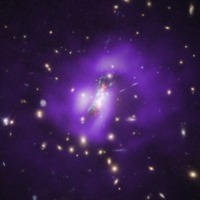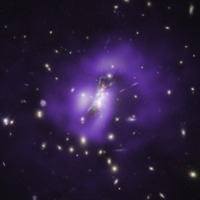Phoenix Cluster
Dublin Core
Title
Description
ABOUT THIS IMAGE
The Phoenix galaxy cluster contains the first confirmed supermassive black hole that is unable to prevent large numbers of stars from forming in the core of the galaxy cluster where it resides.
The Phoenix Cluster system has several distinct elements that help tell the story of its unusually high star formation. Data from NASA's Chandra X-ray Observatory show that the coolest gas it can detect is located near the center of the cluster. In the absence of significant sources of heat, astronomers expect cooling to occur at the highest rates in a cluster’s center, where the densest gas is located.
Optical observations with the Hubble Space Telescope provide evidence for further cooling of gas near the center of the Phoenix Cluster. Ten billion solar masses of cooler gas are located along filaments to the north and south of the black hole, which likely originate from outbursts by the supermassive black hole located in the center of the image. The outbursts generated jets seen in radio waves by the Very Large Array (VLA) radio telescope. As the jets push outward, they inflated cavities, or bubbles, in the hot gas that pervades the cluster. Chandra’s sharp X-ray vision detected these cavities.
This image was made by combining data from Chandra, Hubble and the VLA. X-rays from Chandra depict hot gas in purple and radio emission from the VLA features jets in red. Optical light data from Hubble show galaxies (in yellow), and filaments of cooler gas where stars are forming (in light blue).
ABOUT THE OBJECT
Object Name:
Phoenix Cluster
Object Description:
Cluster of galaxies
Object Position:
R. A. 23:44:40.9
Dec. -42:41:54
Constellation:
Phoenix
Distance:
5.73 billion light-years
Dimensions:
Image is 44 arcsec across (about 1.2 million light-years)

